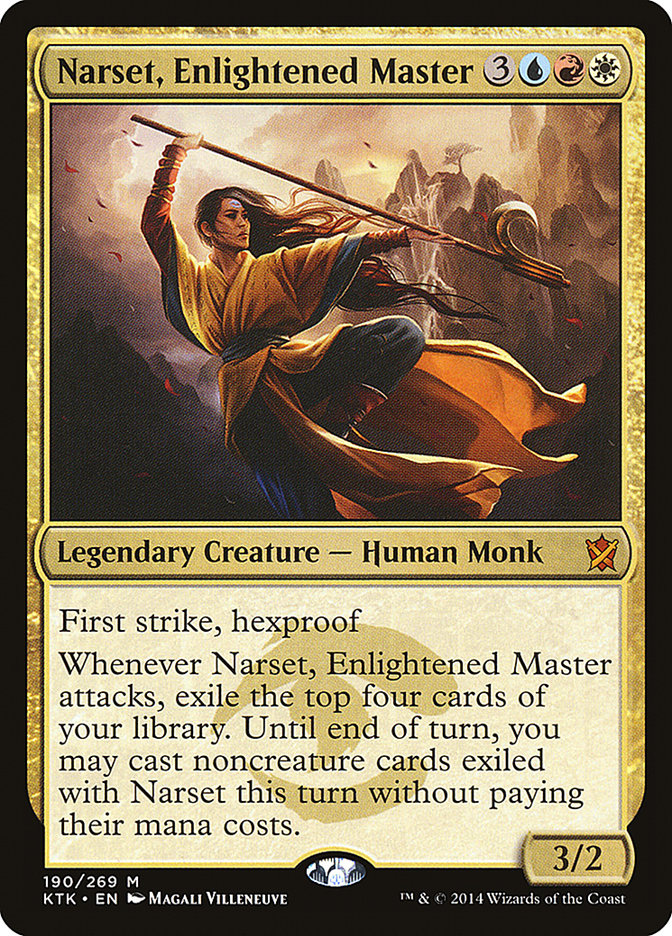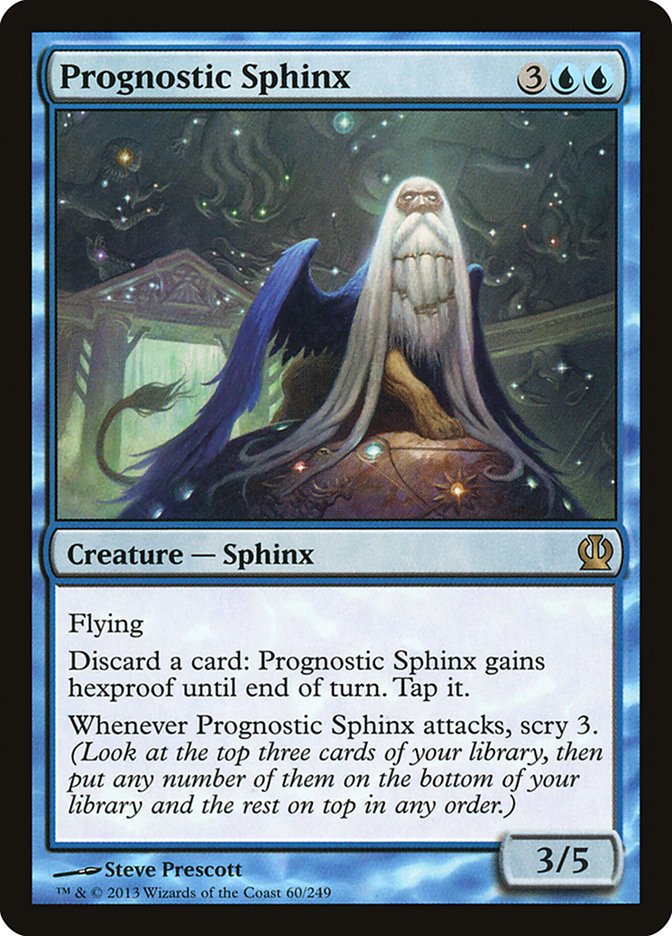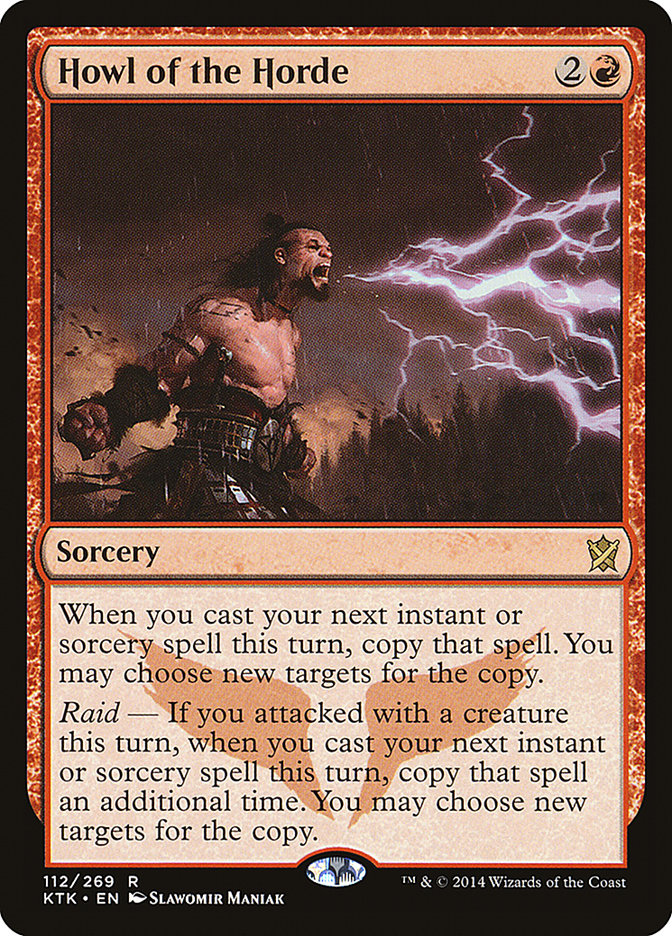Khans of Tarkir brought us some exciting cards: new Standard spells, Commander playables and, as we all know, Legacy and Modern staples. But very few have
driven my interest more than Narset, Enlightened Master.
Just take a second to look at her. Narset is an untargetable finisher that is sizzling with potential. Her stats are fine (Deft Duelist did a similar thing
for a third the cost), but her trigger is really the draw here, and it’s with those free spells that you’ll win the game.
Narset’s power isn’t unknown. Jeskai control shells have slotted a single copy of her in the maindeck or sideboard as an over-the-top finisher, and people
have seen lots of success with her filling this role. Even when I’m playing against someone, tournament or otherwise, I get excited when I see
them stick a Narset. Each time, I’ll exclaim in one form or another, “Alright! What awesome way am I gonna die?” Narset has that kind of power, and she has
that effect on the gamestate. She’s a great commander, and I’d be excited to sleeve her up in a hundred card list.
But we’re not here to discuss a brick of sleeves three inches tall. I’m here to advocate for Narset as a regular part of a balanced decklist, not as a
single copy designed to win once the board has settled. Almost a year ago, my homie Michael Martin wrote an excellent article about user-based planeswalker
rankings where he talked about the quality of planeswalkers ranked by their ability to control the game and make an impact. Jace, Memory Adept was rated
low not because he was a bad planeswalker, but because Jace won the game after the rest of your deck won the game. In fact, Jace, Memory Adept has very little board impact. It’s just the necessary win con for a control deck that utilizes him to move to game 2. In the same way, that’s how
Narset has been; she’s an Aetherling, a Pearl Lake Ancient. But, see, I think she’s got a lot more chutzpa than that.
To make her a central part of the deck though, I’m gonna need to figure out how to make a six-drop that needs to attack a relevant spell early
enough to actually apply pressure to an opponent. Swinging with her on turn 7 and hitting a Lightning Strike seems, well, loose. Thankfully, my favorite
critter from M15 fits the bill nicely.
Not only does the Servant offer an opportunity to get Narset out two full turns early, it bestows the almighty haste on the monk, allowing you to trigger
out of nowhere for maximum value.
While a deck with four of each seems cute, there’s probably room for a couple more creatures. Who else is hard to kill and provides a nice benefit when you
attack?
Yes, the Pearl Lake Ancient alternative is a great choice too. When used in tandem with Narset, the Sphinx can scry before resolving Narset’s
trigger, letting you put pesky lands and creatures to the bottom and maximizing your chance of blow-out spells.
To support this creature base, we need to have lots of high-impact spells that are efficient enough to cast on their own but are most powerful when cast
for free for the purposes of tempo. One attack with a Narset should prove lethal, and we can get there as quickly as turn 4.
Let’s pour ourselves a bowl of Narset Crunch.
Creatures (12)
Planeswalkers (4)
Lands (26)
Spells (18)
Sideboard

Creatures
Well, I pretty much gave away the stable with my intro, but it’s important to note that all of them are full playsets. Generally speaking,
playsets of six-drops is ill-advised in all but the grindiest of matchups. However, bear in mind that Narset is easily countered, Thoughtseized, Wrathed,
or simply blocked out of the game. Having access to a maximum number of copies of a six-drop legendary creature is only necessary if it
is your primary condition to win. Prognostic Sphinx suffers from the same weaknesses, but they are cheaper and amazing in doubles; attack and craft your
next three draws with ruthless precision. I wish I could play more Generator Servants; as soon as people pick up the card to read it, they’re tapping their
mana to cast Magma Jet or Dissolve. Untapping with the Servant opens up your entire deck, and access to an attacking Sphinx on three puts you in a position
of power immediately.
Spells
Narset is only as good as the spells you can hit; luckily, there’s lots of things to help us get to Narset as well as cast with Narset.
Tormenting Voice has proven to be a great card to help an Izzet-hued deck cast Dig Through Time early, and it lets you pitch that awkward third copy of a
win condition in exchange for another card. Magma Jet is better than Tormented Voice in many cases, or is a nice set-up before casting the Wild Guess
variant. It picks off a pesky aggro creature and then provides an immense card selection boost. Few low-powered spells in Standard make me groan more than
Magma Jet.
Jeskai Charm is the meat; four damage to the face, a lifelinking boost, or a Time Ebb all provide a nice incentive to get in the red zone with Narset. In
the same way, Riddle of Lightning leverages the high mana cost of the deck to smash something (your opponent’s face, hopefully), for monumental damage.
Steam Augury is one of the best ways I know to fill up the yard for Dig Through Time, and you can easily pile the stacks to maximize this. Dig Through Time
helps you find that critical piece, whether it’s the win condition itself or the Generator Servant to power it out.
Planeswalkers
Potentially the most exciting thing to do with Narset is cast the best noncreature spells out there: planeswalkers. This smattering of ‘walkers can answer
a number of your woes. Chandra gives you advantage while removing blockers, Jace gives you a repeatable bounce effect, Ajani can make Narset vigilant and
lifelinking, and Sarkhan is a win condition all his own.
Lands
Nothing too fancy in the land department. If they reprint Scalding Tarn, this deck will be ready, but even without, the mana should be good enough. The
white splash is pretty minimal, allowing Narset and Jeskai Charm as well as a couple planeswalkers. Thankfully, one source should always be enough, as
Narset should be able to cast the others without taxing the mana. 26 lands seems important here to be able to hit spells on time. You are casting five- and
six-drops, after all, so in case your little ramp elemental doesn’t show up (or doesn’t live to untap,) then you have a noncreature way to get there.
Sideboard
Naturally, bulky decks like this struggle to beat quick decks. Cards like Anger of the Gods can soften their impact, while cards like Searing Blood can be
used offensively as well as defensively. Triggering off Narset, Searing Blood can pick off a blocker or prevent blocking (if hitting a creature with
toughness between three and five, like Siege Rhino.) Keranos, God of Storms is great for decks that can sweep creatures but can’t kill enchantments. There
are lots of non-white decks that can’t beat a resolved Keranos; bear in mind that, even though Keranos is an enchantment, it cannot be cast with Narset’s
trigger. Deicide could be more relevant than Erase, so based on your metagame (God or non-God,) choose which spell works best for you. Fated Conflagration
helps get rid of those large creatures that get in Narset’s way. At its core, this is a red deck, and it will perpetually struggle with high-toughness
creatures. The scry doesn’t hurt either.
I sleeved this deck up in early October, so I’ve had a couple months to test it out. The verdict?

Well, okay.
In practice this deck was awkward, to say the least. There were far too many copies of each win condition, six mana was a lot of mana, and even against the
decks I thought I’d be best at (slower midrange like Sultai and B/X), the deck didn’t follow through on its promise. Generator Servant was always
dead right away, and the few wins I had were on the back of Prognostic Sphinx, slowly and surely. The deck was purposefully built without counterspells
because they’re bad flips with Narset, but I found I missed having access to them. I applied too little pressure too late in the game to matter, and I was
forced to block surprisingly often with Narset, trading up with a “block plus Magma Jet” play. Tormenting Voice was almost always a disaster, requiring me
to discard a burn spell in hopes of drawing a land. The planeswalkers were not cards at all, and none affected the board enough to ever be a card I wanted
to draw or flip with Narset, which itself happened fairly infrequently.
On the plus side, mana-fixing was not a problem. I always had access to my colors, and the sideboard turned out to be pretty decent. Deicide is a pretty
good removal spell in our format, despite the fact that Gods aren’t too common. I found I exiled Courser of Kruphix much more often than deities. Fated
Conflagration was, again, a great option out of the board.
Let’s rework the maindeck then, to be more finely tuned and relevant early.
Creatures (10)
Lands (26)
Spells (24)
- 4 Magma Jet
- 4 Riddle of Lightning
- 4 Divination
- 4 Stoke the Flames
- 2 Howl of the Horde
- 4 Jeskai Charm
- 2 Dig Through Time
Sideboard

The planeswalkers got nixed and I upped the burn spell count, converting the deck into a front-loaded removal-centric package. It could now win without a
creature, but creatures would significantly help the process.
This new version did much better; playing it over a couple weeks online (as opposed to in proxied paper) suggested this iteration was much more
well-rounded. Divination was roughly 4000 times more effective, and the deck included some new spells to keep things spicy, namely Howl of the Horde.
If you’re able to cast this after attacking with Narset (presumably with her trigger), you’re gonna be tripling your burn damage. In one
particular game, where an aggressive Mardu deck managed to get to 26 thanks to a Sorin, Solemn Visitor and a massive Butcher of the Horde, I furiously
untapped, cracked my Servant (his list was removal light game 1), smashed with a fresh Narset and hit a Howl of the Horde and two Riddle of
Lightning, where the Riddle put another Narset on top, smacking him for 24 damage with my two copies (finding the same Narset on top) and following up with
Narset’s three combat damage was enough to close the game. With a more proactive build, I didn’t miss the counterspells; the lines were more obvious and
the list was overall much easier to pilot. There were other games where an aggressive fetching and Thoughtseize campaign from my opponent put them within
burn range without ever attacking with a creature. Burn is still real, folks–watch that life total.
After testing, I still drew one too many finishing creatures on occasion, but other times, I was desperate to draw anything to apply pressure on
an empty board. The burn spells were strong, and the sideboard felt more correct and impactful (you board in Goblin Rabblemaster against literally
everything but mono-red). I didn’t miss not having Deicide/Erase, and Negate felt like a necessary evil against the control deck’s Perilous Vault and End
Hostilities.
We just celebrated Thanksgiving, and while I’m happy for my wife, her family, my own family, my friends, and my job (both day and Magic-oriented), I’m also
really thankful for you, my readers. I love bringing fun decks to you every week, and I hope that, even if the decks themselves don’t tickle your
fancy, they at least pique your brain for invention, and knowing you all, you’re able to craft something far superior that can wow everyone in your local
playgroup.
On that note, is it helpful for you to see the previous iterations of a deck in my article? I find it personally enlightening to realize where a concept
starts and what doesn’t work, but I can also see that you all could just want to see the final product.
I’m shocked I hadn’t touched on Narset until now, but where have you been going with this masterful monk?




